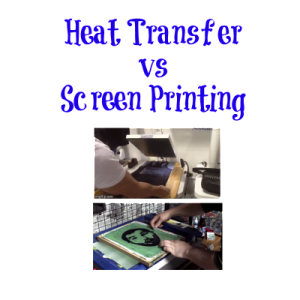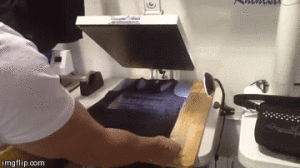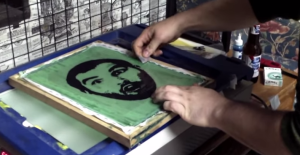Heat Transfer vs Silk Screen Printing – Pros and Cons

Today, people prefer to have their own unique design t-shirts and they want to stand out from the crowd instead of blending in. When you want to add a unique design to your t-shirt, there are two primary methods to choose from – silk screen printing and heat transfer printing. Many people are confused whether heat transfer or silkscreen printing is better for t-shirts. Both processes have their own pros and cons. Here is a detailed picture of these two types of printing.
Heat Transfer

Heat transfer is a process of printing garments in which the printed design is transferred from the paper to the garment through heat and pressure. In this process, art work is printed with specialty ink on specialty paper and then transferred to a garment by applying heat with a heat press. Heat-applied materials contain a heat-sensitive adhesive on one side and when heat is applied by a heat press to the material, the material adheres to the substrate to which it is being applied. Transfer printing is rapidly gaining importance in the textile industry. This process lets you to print full color images on garments. The recent advancements in heat transfer technologies have made this process better and it is also easier to make this type of printing on garments, but this is a time consuming process. On average, it takes about three minutes to print an item.
There are different types and sources of transfers. Generally, a transfer is made up of a carrier paper and inks. When heat and pressure are applied to this paper the inks are transferred to the substrate you wish to print on to. Some transfers are topical, the image is applied to the surface of the substrate, and some other transfers are absorbed into the fibers of the material and they are called sublimation transfers.
Heat transfer Pros
- Heat transfer printing is clean and environmentally safe, which makes it appealing in today’s health and safety conscious work environments.
- Use of specially formulated inks, and advances in graphics and software packages give the operators’ greater control and flexibility which results in better quality end products.
- Can use several colors, as long as they do not overlap.
- Photographic material can be pressed.
- They can be inexpensive for small runs of printing.
Cons
- Expensive set-up costs and expensive on large quantities of garments.
- Cannot layer colors because the t-shirt will become bulky and heavy.
- The print does not last long.
- The print may fade after a few washes.
- They do not look as professional as a silk screen printed t-shirt.
- You can print only on light-colored t-shirts.
- The print is stiff and not as precise.
- The print does not breathe well and may provoke sweating.
- Cannot iron the print.
Silk Screen Printing

Silk screen printing is a traditional and most widely used method to print on different materials, anything from t-shirts, fabrics and even wood. This is a process in which images are created through a type of stencil process.
Artwork is separated into its different colors, and then screens are burned with all the different color separations. Since the different colors have to be lined up perfectly, the art work is limited to the number of screens a specific printing machine can hold. Most of the printing machines can hold up to six screens and this limits the printing of artwork up to six colors.
Silk Screen Printing Pros
- Perfect for larger designs consisting of one or two colors.
- Ideal for printing onto cotton and poly cotton clothing items.
- The garments with silk screen printing can withstand the roughness of machine washing as the ink is heat dried.
- The print will be bright even on the dark fabrics.
- Softer feel than transfers.
- Can iron the print.
- Cost effective on larger quantities.
- They have no limits on size and it is possible to do all over prints.
Cons
- Expensive on smaller quantities.
- As each color is applied separately, the making cost gets higher with every additional color.
- Separate screens are used for each individual color. So, for each additional color, a new screen has to be used.
- This is not the best option if the design consists of several colors.
- Coated fabrics cannot be screen printed.
- If there are many colors to be used, the turnaround time gets longer.
- It is time consuming to set up and clean.
Heat Transfer vs Silk Screen Printing
- Heat transfer printing is very convenient and the level of detail is better than screen print. The costs involved are minimal and the set up time in very less. You can have your finished t-shirt with little or no clean up.
- Although the process of transfer printing sounds easier, it is a time consuming process and each item produced requires an average of three minutes to produce.
- With screen printing the initial set up will take a little longer, but after that each t-shirt can be produced in a matter of seconds.
- In screen printing, there is a limit to the number of colors used as the machines have a limit in the number of screens they can hold.
- For small batches of t-shirts, heat transfer is a cheaper option, but with larger quantities, screen printing becomes cheaper.
- When it comes to the number of colors used for a print, transfer prints do not have a limit and you can print an image with any number of colors.
If you are in the business of making t-shirts for other businesses, then you may need to go in for the silk screen printing method. But if you are in promoting your own line of t-shirts, transfer printing is a cheaper and faster alternative.